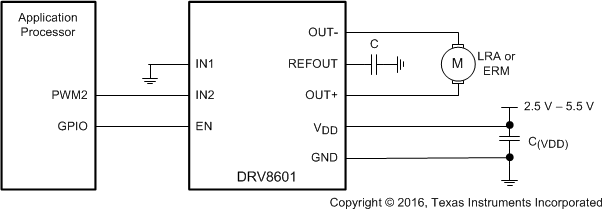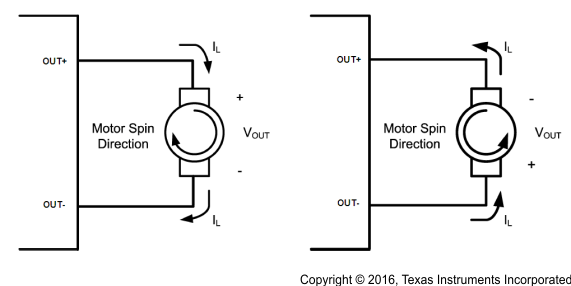SLOS629D July 2010 – October 2016 DRV8601
PRODUCTION DATA.
- 1 Features
- 2 Applications
- 3 Description
- 4 Revision History
- 5 Pin Configuration and Functions
- 6 Specifications
- 7 Detailed Description
- 8 Application and Implementation
- 9 Power Supply Recommendations
- 10Layout
- 11Device and Documentation Support
- 12Mechanical, Packaging, and Orderable Information
パッケージ・オプション
メカニカル・データ(パッケージ|ピン)
サーマルパッド・メカニカル・データ
- DRB|8
発注情報
7 Detailed Description
7.1 Overview
DRV8601 is a single-supply haptic driver that is optimized to drive ERM or LRAs. DRV8601 can drive in both clockwise and counter-clockwise directions, as well as stop the motor quickly. This is possible due to the fact that outputs are driven differentially and are capable of driving or sinking current. DRV8601 also eliminates long vibration tails which are undesirable in haptic feedback systems.
The DRV8601 can accept a single-ended PWM source or single-ended DC control voltage and perform single-ended to differential conversion. A PWM signal is typically generated using software, and many different advanced haptic sensations can be produced by inputting different types of PWM signals into the DRV8601.
7.2 Functional Block Diagram

7.3 Feature Description
7.3.1 Support for ERM and LRA Actuators
Linear vibrators (also known as Linear Resonant Actuators or LRA in haptics terminology) vibrate only at their resonant frequency. Usually, linear vibrators have a high-Q frequency response, due to which there is a rapid drop in vibration performance at offsets of 3 to 5 Hz from the resonant frequency. Therefore, while driving a linear vibrator with the DRV8601, ensure that the commutation of the input PWM signal is within the prescribed frequency range for the chosen linear vibrator. Vary the duty cycle of the PWM signal symmetrically above and below 50% to vary the strength of the vibration. As in the case of DC motors, the PWM signal is typically generated using software, and many different advanced haptic sensations can be produced by applying different PWM signals into the DRV8601.
 Figure 13. LRA Example for 1/2 Full-Scale Drive
Figure 13. LRA Example for 1/2 Full-Scale Drive
The DRV8601 is designed to drive a DC motor (also known as Eccentric Rotating Mass or ERM in haptics terminology) in both clockwise and counter-clockwise directions, as well as to stop the motor quickly. This is made possible because the outputs are fully differential and capable of sourcing and sinking current. This feature helps eliminate long vibration tails which are undesirable in haptic feedback systems.
 Figure 14. Reversal of Direction of Motor Spin Using DRV8601
Figure 14. Reversal of Direction of Motor Spin Using DRV8601
Another common approach to driving DC motors is the concept of overdrive voltage. To overcome the inertia of the mass of the motor, they are often overdriven for a short amount of time before returning to the rated voltage of the motor in order to sustain the rotation of the motor. The DRV8601 can overdrive a motor up to the VDD voltage. Overdrive is also used to stop (or brake) a motor quickly. The DRV8601 can brake up to a voltage of –VDD. For safe and reliable overdrive voltage and duration, refer to the data sheet of the motor.
7.3.2 Internal Reference
The internal voltage divider at the REFOUT pin of this device sets a mid-supply voltage for internal references and sets the output common mode voltage to VDD/2. Adding a capacitor to this pin filters any noise into this pin and increases the PSRR. REFOUT also determines the rise time of VO+ and VO when the device is taken out of shutdown. The larger the capacitor, the slower the rise time. Although the output rise time depends on the bypass capacitor value.
7.3.3 Shutdown Mode
DRV8601 has a shutdown mode which is controlled using the EN pin. EN pin is 1.8-V compatible. By pulling EN pin low, the device enters low power state, consuming only 10 nA of shutdown current.
7.4 Device Functional Modes
DRV8601 is an analog input with differential output. DRV8601 does not require any digital interface to set up the device. DRV8601 can be configured in various modes by configuring the device in differential or single ended mode as described in Application and Implementation.